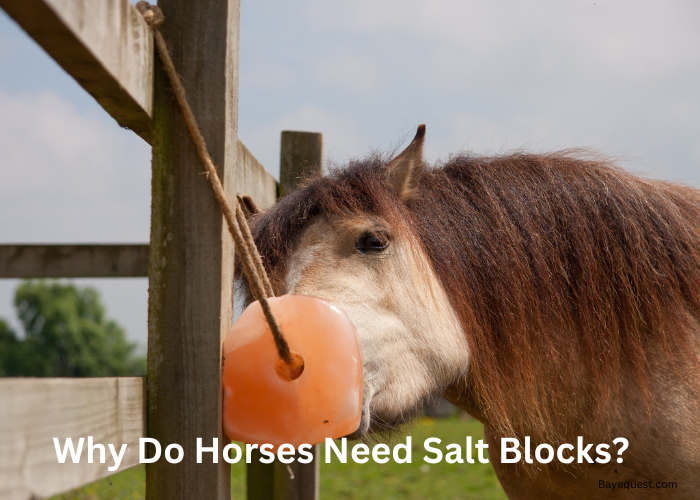Salt isn’t just for fries. Horses need it to stay healthy and strong.
When people sweat, they lose important minerals, especially salt. This happens more in hot weather or during hard work.
Without enough salt, muscles can cramp. Energy drops. Even digestion can slow down.
That’s why salt blocks are more than just a treat. They’re a daily must-have.
But why isn’t regular feed enough? And how much salt does a horse really need?
Let’s dig into the facts and see why a simple block makes such a big difference.
Why Do Horses Need Salt Blocks? Key Takeaway
Horses need salt blocks to stay healthy. Salt helps with hydration and muscle function. It supports nerve activity and prevents deficiencies. Horses lose salt through sweat and urine. Their diet often lacks enough salt. A salt block fills this gap. It keeps horses balanced, active, and healthy.
What are Salt Blocks for Horses?
Salt blocks are solid chunks of salt made for horses. They provide essential minerals like sodium and chloride.
These minerals help with hydration, muscle function, and nerve activity. Horses lose salt through sweat and urine. Their regular diet often doesn’t have enough salt.
Horse salt blocks come in different types. Some are plain, while others have added minerals.
Himalayan salt blocks are also popular. Horses lick these blocks to get the salt they need.
Placing them in stables or pastures makes them easy to access. Salt blocks keep horses healthy and balanced.
Types of Salt Blocks for Horses
Not all salt blocks are the same. Each type serves a unique purpose and offers specific benefits.
Let’s break down the most common types and what makes each one special.
Plain salt blocks
Plain salt blocks are the most basic type available. They are made from pure sodium chloride.
These blocks provide horses with essential salt to maintain hydration and electrolyte balance.
They are usually white and inexpensive. Plain salt blocks are a good choice for horses on balanced diets with other supplements.
However, they don’t offer additional minerals. These blocks are best suited for horses that need only basic salt replenishment.
They can be placed in stables or pastures. Horses will lick them as needed.
Himalayan salt licks
Himalayan salt licks are pink and naturally sourced from ancient salt mines. They are rich in trace minerals like potassium, calcium, and magnesium.
These minerals support bone strength, muscle function, and overall health. The pink color comes from the minerals trapped in the salt.
Himalayan salt licks are hard and weather-resistant, making them suitable for outdoor use.
Horses enjoy their natural taste, and they tend to last longer than plain blocks. These licks are often hung in stables or placed in holders.
Sulfur salt blocks
Sulfur salt blocks combine sodium chloride with sulfur. Sulfur is essential for healthy skin, hooves, and coat.
It also supports joint health and digestion. These blocks are often yellow in color.
They are beneficial for horses with skin issues or brittle hooves. However, not all horses need extra sulfur in their diet.
Overconsumption can lead to imbalances. These blocks should only be used when a sulfur deficiency is confirmed.
They are best placed in areas where horses can access them freely but not excessively. Always consult a vet before offering sulfur salt blocks.
Garlic salt blocks
Garlic salt blocks combine salt with garlic extracts. Garlic is believed to support respiratory health and repel insects.
These blocks are often used in the summer months when flies are more active. Horses tend to enjoy the taste of garlic, making these blocks appealing.
Garlic also has natural antibacterial properties.
However, too much garlic can be harmful over time. Therefore, these blocks should be used in moderation.
Mineralized salt blocks
Mineralized salt blocks contain sodium chloride and added trace minerals. These include zinc, copper, iron, and manganese.
Each mineral plays a key role in a horse’s health. Zinc supports immune function, while copper aids in joint health.
These blocks are red or brown in color. They are great for horses on diets lacking variety or essential nutrients.
However, they are not a replacement for a well-rounded diet. Mineralized salt blocks should be placed in stables or pastures where horses can access them freely.
Why Do Horses Need Salt Blocks?
Horses need salt blocks to stay healthy and balanced. Salt provides essential minerals like sodium and chloride.
These minerals are crucial for hydration, muscle function, and nerve activity.
Horses lose salt through sweat, urine, and daily activity. Their regular diet often doesn’t provide enough salt to meet their needs.
Without enough salt, horses can become dehydrated, weak, and tired. They may also show unusual behaviors like licking walls or eating dirt.
Salt blocks give horses a reliable source of these vital minerals.
By licking a salt block, horses can regulate their salt intake naturally. This helps prevent deficiencies and supports overall well-being.
Different types of salt blocks offer added benefits, depending on the horse’s diet and health needs.
Providing a salt block is a simple yet effective way to keep your horse healthy, strong, and active.
Interesting read: What Horses Cannot Eat.
The Role of Salts in a Horse’s Diet
Salt is one of the most important nutrients in a horse’s diet. It provides two key minerals: sodium and chloride.
Sodium helps regulate fluid balance in the body. It ensures that cells stay hydrated and function properly.
Chloride works alongside sodium to maintain the right pH levels in the horse’s body. Together, they support digestion and prevent muscle cramps.
Horses lose salt daily through sweat, urine, and manure. Hot weather, exercise, and stress can increase these losses.
If horses don’t get enough salt, they may become weak, tired, or even dehydrated.
A salt deficiency can also cause behavioral changes. Horses might start licking walls, chewing wood, or eating dirt to find salt.
Providing access to a salt block helps horses naturally regulate their intake. It’s a simple way to keep them healthy, hydrated, and performing at their best.
How Much Salt Does a Horse Need?
The amount of salt a horse needs depends on its size, activity level, and environment.
On average, a healthy adult horse requires about 1-2 ounces (28-56 grams) of salt per day. This is the baseline for horses at rest in mild weather.
However, horses in hot climates or those that exercise heavily lose more salt through sweat.
In such cases, their daily salt needs can increase to 4-6 ounces (113-170 grams) or more.
Most commercial feeds and hay don’t provide enough salt to meet these needs. That’s why providing a salt block is essential.
Always ensure fresh, clean water is available when offering salt blocks. Excessive salt without water can cause dehydration.
Also, regularly monitor your horse’s salt intake and look for signs of deficiency, like fatigue or unusual licking behaviors.
Then remember to adjust their salt supply based on their workload and the weather.
How to Calculate the Amount of Salt in the Current Diet of a Horse
Calculating the salt in your horse’s diet ensures they get the right amount for their needs. Here’s a simple step-by-step guide:
Check feed and supplement labels
- Look at the labels on your horse’s feed and supplements.
- Note the percentage of sodium (Na) and chloride (Cl) listed.
Convert to daily intake
Multiply the percentage of sodium and chloride by the daily amount of feed your horse consumes.
Example: If your horse eats 5 kg of feed daily, and the feed contains 0.5% sodium:
5 kg × 0.5% = 25 g of sodium per day.
Add salt from supplements
If your horse gets salt supplements, add that amount to the total.
Example: If you add 1 ounce (28 g) of loose salt daily, include that in your total.
Compare to recommended intake
An average horse needs about 1-2 ounces (28–56 g) of salt daily.
Adjust based on activity level and climate.
Evaluate salt block usage
Monitor how often your horse uses the salt block.
If the block is barely used, they might be getting enough salt from feed and supplements.
Adjust accordingly
If there’s a gap between the recommended and current intake, adjust their diet or placement of salt blocks.
Signs of Salt Deficiency in Horses
Salt deficiency can affect a horse’s health and behavior. Here are the most common signs to watch for:
Lethargy and fatigue
- Horses may seem tired, weak, or unwilling to move.
- Performance during work or exercise may drop noticeably.
Decreased appetite
- Horses might lose interest in their regular feed.
- Reduced food intake can lead to weight loss over time.
Unusual behaviors
- Horses may lick walls, fences, or soil.
- Chewing on wood or other non-food items is also common.
Dry or sticky mucous membranes
- Gums and tongue may feel dry or tacky.
- This is often a sign of dehydration caused by salt imbalance.
Poor coat condition
- The coat may look dull or rough.
- Skin issues might also appear over time.
Muscle cramps or stiffness
- Horses may experience muscle tremors or stiffness.
- Severe deficiencies can lead to spasms or difficulty moving.
Reduced water intake
- Without enough salt, horses may drink less water.
- This can quickly lead to dehydration.
Best Salt Blocks for Horses
Selecting the right salt block is essential for your horse’s health. Here are some top-rated brands to consider:
1. Horsemen’s Pride Himalayan Salt Block on Rope
This 100% natural Himalayan salt block comes with an attached rope for easy hanging in stalls or pastures. It provides essential minerals like iron, potassium, and magnesium.
2. Redmond Rock on a Rope Unrefined Salt Rock
Mined in the USA, this unrefined salt rock offers over 60 trace minerals. Its natural composition supports hydration and overall health.
3. Glowyn Pink Himalayan Salt Lick
This organic pink salt block is rich in minerals and comes with a rope for convenient hanging. It’s designed to withstand weather conditions, making it suitable for outdoor use.
4. UMAID Himalayan Salt Lick on Rope
Weighing around 6 pounds, this natural salt lick provides essential minerals and includes a sturdy rope for hanging. It’s suitable for horses, deer, goats, and other livestock.
5. Champions Choice Trace Mineral Salt Block
This 50-pound block contains a blend of essential trace minerals, supporting overall health in horses. It’s durable and weather-resistant, ideal for pastures with multiple horses.
Do I Need a Salt Block Holder for Horses?
A salt block holder isn’t always necessary, but it offers several benefits that can make salt blocks more effective and long-lasting.
Prevents waste
- Without a holder, salt blocks can end up on the ground.
- Blocks exposed to dirt, mud, or manure may become contaminated or dissolve faster.
Keeps the block secure
- A holder keeps the salt block in place.
- This prevents it from being kicked, stepped on, or broken.
Improves accessibility
- Holders position the block at a comfortable height for horses.
- This makes it easier for them to lick without straining.
Reduces mess
- Water and urine can cause salt blocks on the ground to dissolve unevenly.
- A holder ensures better use and less mess.
Extends lifespan
- Keeping the block elevated helps it last longer.
- It also prevents rapid dissolving from moisture exposure.
Types of Salt Block Holders for Horses
Salt block holders keep salt clean, secure, and easy for horses to access.
With different designs available, each type serves a specific purpose based on where and how it will be used.
Let’s explore the most common options and their benefits.
Wall-mounted salt block holders
Wall-mounted salt block holders are fixed directly to stable walls or fences.
They keep salt blocks off the ground, protecting them from dirt, mud, and manure. This setup ensures the block stays clean and lasts longer.
Horses can comfortably lick the salt without straining their necks. These holders are sturdy and easy to install.
They work best with rectangular or square salt blocks.
Wall-mounted holders are a great choice for indoor stalls where space is limited, and hygiene is a priority.
Hanging salt block holders
Hanging salt block holders are perfect for Himalayan salt licks or blocks with pre-drilled holes.
They usually come with a rope or chain for easy suspension.
These holders allow the block to swing freely, preventing damage from chewing or biting.
Horses enjoy the natural movement of the block while licking. Hanging holders are versatile and can be used in stalls or outdoor areas.
They are weather-resistant and easy to set up, making them a convenient option for many horse owners.
Corner salt block holders
Corner salt block holders are designed to fit snugly in the corner of a stall or stable. They save space while keeping the salt block secure and accessible.
The corner placement reduces the risk of the block being knocked loose or wasted.
These holders are often made of sturdy plastic or metal for durability. Horses can comfortably reach the salt without crowding the space.
Corner holders are ideal for smaller stalls where every inch of space matters.
Ground or floor salt block holders
Ground salt block holders are built to sit directly on the ground but are slightly elevated to prevent sinking into mud or manure.
They are typically made of heavy-duty, weather-resistant materials. These holders are ideal for outdoor pastures where horses roam freely.
The design keeps the salt block stable and reduces waste from weather exposure. They are especially useful for herds or larger groups of horses.
Ground holders are easy to move and refill, offering flexibility in placement.
Multi-block salt holders
Multi-block salt holders are designed to hold more than one salt block at a time.
They are perfect for pastures or areas where multiple horses share the same space.
These holders reduce the need for frequent refilling, saving time and effort.
They are usually mounted on fences or built into sturdy frames. Multi-block holders ensure every horse has access to salt, minimizing competition.
They are an efficient solution for large stables or outdoor herds.
Bucket-style salt holders
Bucket-style salt holders resemble small troughs or buckets. They can hold loose salt or small salt blocks.
These holders are portable and easy to refill. Horses that prefer loose salt often do well with this setup.
Bucket holders are lightweight but stable, making them easy to move around. They are great for use in stalls, barns, or temporary setups.
This type of holder offers flexibility for owners who want to adjust placement regularly.
Common Myths About Salt Blocks for Horses
There are many misconceptions about salt blocks and their role in a horse’s diet. Let’s clear up some of the most common myths:
1. Horses get enough salt from their feed and hay
2. Too much salt is dangerous for horses
3. All salt blocks are the same
4. Horses don’t like salt blocks
5. Salt blocks are only for summer
6. Salt blocks can replace a balanced diet
Salt Vs Mineral Blocks for Horses
A salt block gives horses plain sodium chloride, just what they need to stay balanced, especially in hot weather or after exercise.
But horses also need minerals, like calcium, magnesium, zinc, and selenium. That’s where mineral blocks come in.
They include salt, plus those extra nutrients. It’s like upgrading from plain water to a sports drink with electrolytes.
So which one should you choose?
If your horse is already on a balanced feed and getting supplements, a plain salt block might be enough.
But if your horse is on pasture or basic hay without a complete grain mix, a mineral block helps fill in the gaps.
Also, some horses don’t lick blocks enough. In that case, consider loose salt or loose minerals instead.
Salt and Mineral Blocks for Horses: Conclusion
Salt blocks are essential for keeping horses healthy and balanced.
They provide vital minerals like sodium and chloride, supporting hydration, muscle function, and nerve activity.
With different types available, each block serves unique needs, from basic salt intake to added minerals.
Proper placement and, if needed, a salt block holder ensure easy access and prevent waste.
Regular monitoring helps ensure your horse gets the right amount of salt.
Simple, affordable, and effective, salt blocks are a must-have for every horse owner. A well-licked salt block means a happy, healthy horse.








